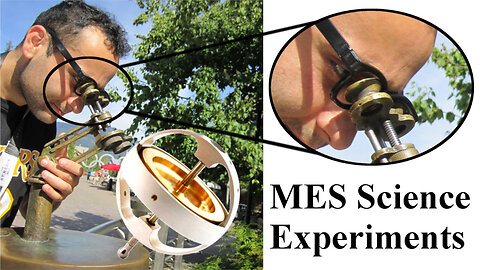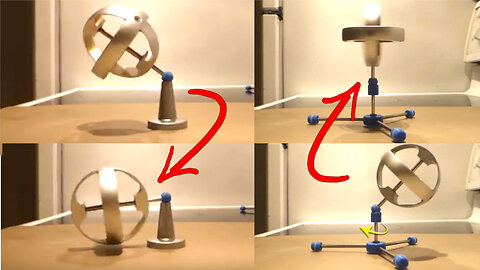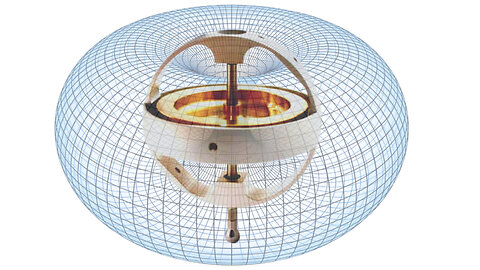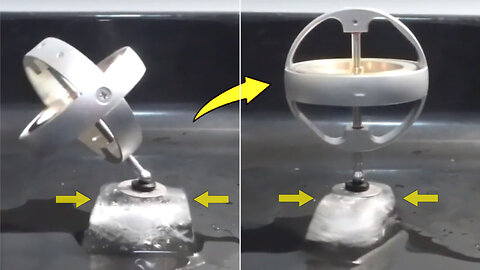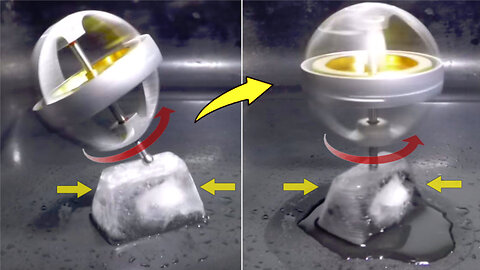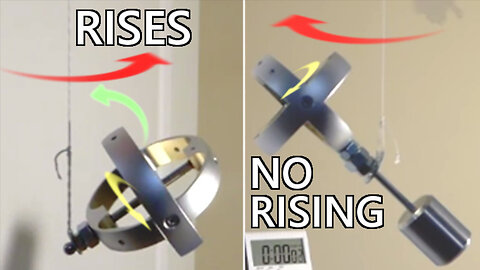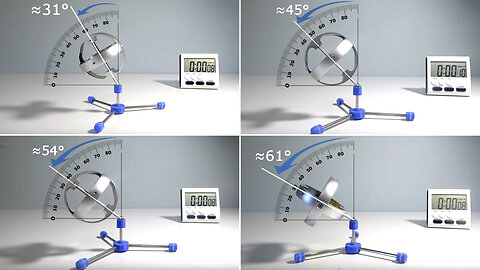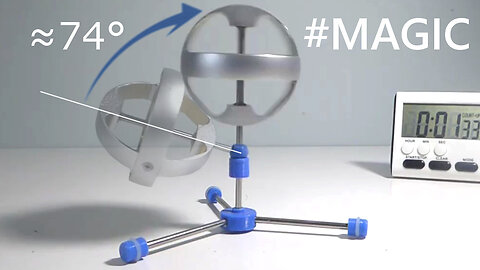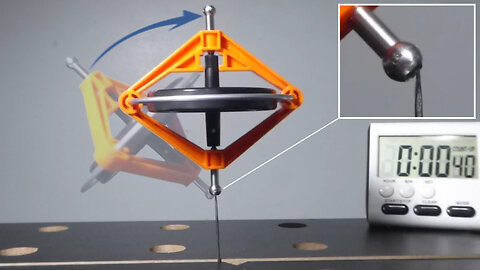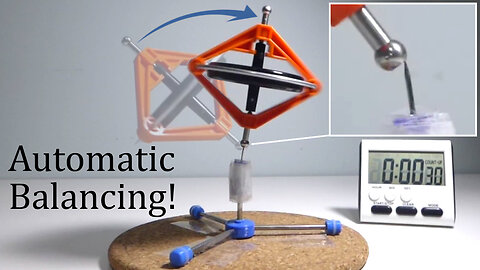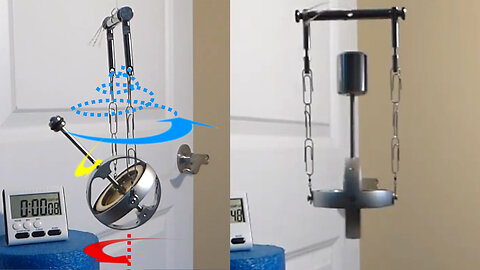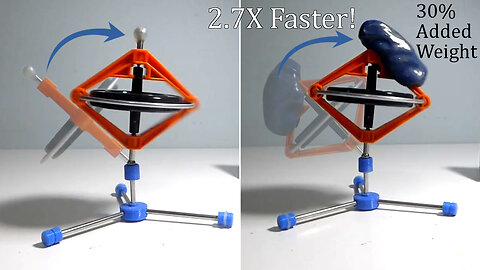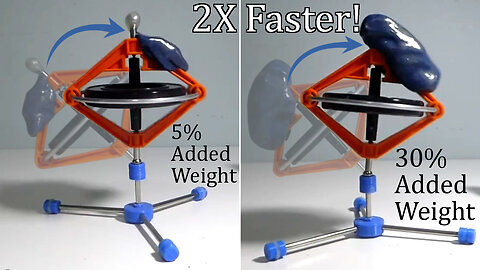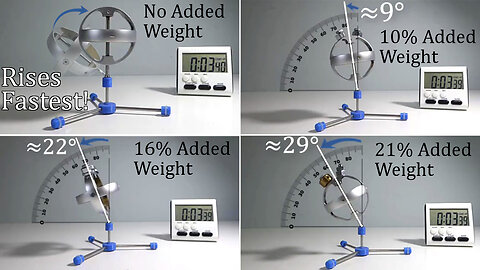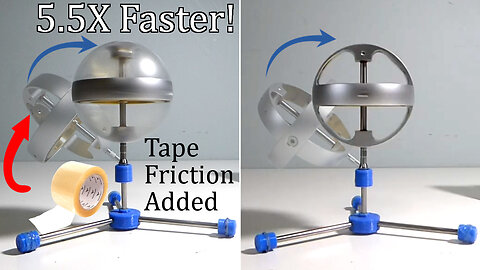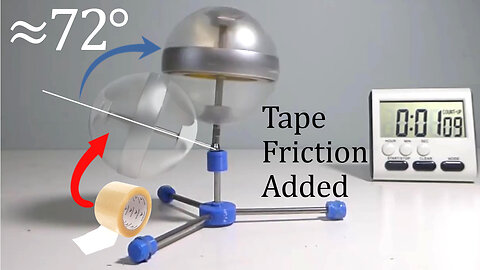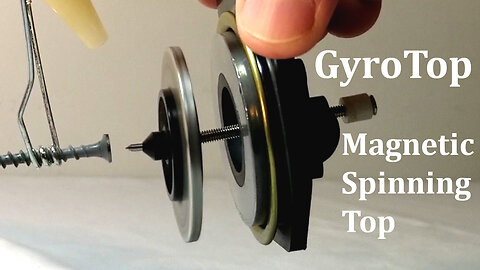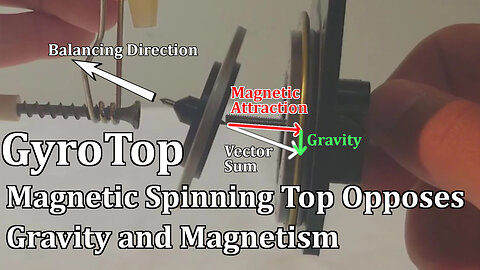🔬#MESExperiments - Introduction to MES Science Experiments!
🔬#MESExperiments 1: Gyroscopes Precess Upwards on Low Friction & Rotating Surfaces
🔬#MESExperiments 2: Super Precision Gyroscope Precesses Upwards Even at Very Steep Angle
🔬#MESExperiments 3: Gyroscopes Exert 'Inertial Forces' With Zero Loss of Spin Rate
🔬#MESExperiments 4: Gyroscopes Precess with Zero ‘Angular Momentum’
🔬#MESExperiments 5: Gyroscopes Precess Upwards on Ice with Zero Centripetal Force
🔬#MESExperiments 6: Gyroscopes Precess with Zero Centripetal Force on Ice Even at Horizontal Angle
🔬#MESExperiments 7: Gyroscopes Precess Upwards on Ice Even While Outer Casing Spins
🔬#MESExperiments 8: Large Gyro Wheel Precesses at 1000X Torque Over-Unity
🔬#MESExperiments 9: Gyroscope With Counterweight Hung on a String Rises 'DOWNWARDS'!
🔬#MESExperiments 10: Gyroscopes on a String Can Rise But Not if Sufficient Counterweight is Added
🔬#MESExperiments 11: Increasing Gyroscope Spin Speed Doesn't Necessarily Increase Rising Rate
🔬#MESExperiments 12: Gyroscopes at Steeper Angles Usually Means Exponentially Longer Rising Times
🔬#MESExperiments 13: Steepest Gyroscope Rising Experiment Ever! 74 Degrees from the Vertical
🔬#MESExperiments 14: Angle of Gyroscope Has Little Effect on Rate/Period of Precession
🔬#MESExperiments 15: Gyroscopes Tend to Rise Until Precession Rate Has Peaked #Interesting
🔬#MESExperiments 16: Gyroscopes Can Even Rise on the Tip of a Thin Needle!
🔬#MESExperiments 17: Gyroscopes Can Even Rise on a Slanted Needle
🔬#MESExperiments 18: Gyroscopes Even Rise on a Flimsy Rotating Needle
🔬#MESExperiments 19: A Gyroscope is an Inverted Pendulum Without Electronic Sensors
🔬#MESExperiments 20: Forced Precession of a Gyroscope Generates Inertial Lift (i.e. Weight Loss)
🔬#MESExperiments 21: Added Weight Can Make a Gyroscope Rise Faster
🔬#MESExperiments 22: Added Weight Can Make a Gyroscope Rise Faster (No Casing Rotation)
🔬#MESExperiments 23: Added Weight Doesn’t Always Make Gyroscopes Rise Faster #Nuance
🔬#MESExperiments 24: Gyroscope Rises Even With 70% Added Weight #Amazing
🔬#MESExperiments 25: Increasing Spin Friction Can Make Gyroscopes Rise Much Faster
🔬#MESExperiments 26: Increasing Spin Friction Can Make a Gyroscope Rise from a Very Steep 72° Angle
🔬#MESExperiments 27: Spin Friction Can Make Gyroscope Rise from Steep 70° Angle (No Casing Rotation)
🔬#MESExperiments 28: Magnetic Spinning Top Aligns Opposite of Magnetic Attraction
🔬#MESExperiments 29: Magnetic Spinning Top Aligns Opposite of Asymmetric Magnetic Attraction
🔬#MESExperiments 30: Magnetic Spinning Top Aligns Opposite of Both Gravity and Magnetic Attraction
🔬#MESExperiments 31: Mechanical Demonstration of Inertia by Francis McCabe
🔬#MESExperiments 32: Comparing Tippe Top, Phi Top, and Gyroscope Rising Tests
🔬#MESExperiments 11: Increasing Gyroscope Spin Speed Doesn't Necessarily Increase Rising Rate
In #MESExperiments 11 I go over several gyro rising experiments comparing different gyros to various initial spin speeds in order to understand how the rate of rising is affected by initial spin speeds. I compare 3 different gyroscopes and 2 different initial spin speed types: full speed and a delayed start. The 3 gyroscopes include a small plastic gyro (29.10 grams), a UFO light-up plastic/metallic gyro (134.39 g), and a metallic precision gyro (150.68 g). For each gyro I have placed the experiments side-by-side to better compare their behavior. The delayed start time for the small gyro is 30 seconds, for the UFO gyro it is 1 minute, and for the precision gyro it is 3 minutes. All the experiments had angles very close to 45 degrees from the vertical but it should be noted that even a 1 degree difference can have a drastic impact on the rising rate or even the ability to rise.
The findings show that the small gyro and the UFO gyro rose faster when delayed indicating that slower spin rate helped increase rising rate. But the opposite happened with the precision gyro in that the faster spin speed with no delay rose faster. These are are very interesting findings and require further investigation. It is also important to note that the weight of the gyro spinning mass and non-spinning mass are key components in the gyro's magical ability to rise; and which can even allow the gyro to generate torque over-unity in lifting relatively heavy weight as demonstrated in my game-changing #AntiGravity Part 6 video, https://mes.fm/antigravity-playlist.
Note that the video thumbnail has the full speed rising time shown in the above vertical gyros while the bottom are the initial starting positions of the delayed start gyros.
The full results of each experiment are shown in the accompanying Hive article and Excel File:
View video notes on the Hive blockchain: https://peakd.com/mesexperiments/@mes/mesexperiments-11-increasing-gyroscope-spin-speed-doesn-t-necessarily-increase-rising-rate
Excel File: https://1drv.ms/x/s!As32ynv0LoaIh-53X75dowZjPNboJA
Note that the rising rate increases for the small and UFO gyro but decreases for the precision gyro. Also interesting is the rising rate for the precision gyro is several times smaller than the other gyros. Furthermore the full speed gyros were in the "sleep" or vertical position for longer and as well as taking longer to fully fall down. This may be due to the minimal bearing friction in the vertical position.
Note that further, more detailed experiments are required to quantitatively measure the spin speeds as well as the relative weights of the spinning vs non-spinning mass. Also in the works is that I'm trying to obtain a gyro wheel with no outer casing at all to get a better understanding of how the gyro behaves with no non-spinning mass. I will also be looking to get a battery powered gyro wheel with variable and uniform spin speed control to further understand the magic of gyros; if you are able to make one or know of a place that sells it please get in contact with me at contact@mes.fm.
It is also worth noting that the according to the website I purchased the 150.68 g precision gyroscope from, the weight of the spinning brass disk including the rotating shaft is 112 g. Thus the ratio of the spinning mass to the total weight is 112/150.68 = 0.7433 = 74.33 %. I believe weighing the spinning rotors of the small toy gyro and UFO gyro and comparing the relative spinning mass ratio with the precision gyro may reveal further important information regarding the rising rates; which I will look to dissemble soon.
Stay Tuned for #MESExperiments 12…
Related Videos:
#MESExperiments video series: https://peakd.com/mesexperiments/@mes/list
DRAFT #MESExperiments video series: https://mes.fm/experiments-draft
#AntiGravity video series: https://peakd.com/antigravity/@mes/series
#FreeEnergy video series: https://mes.fm/freeenergy-playlist .
------------------------------------------------------
SUBSCRIBE via EMAIL: https://mes.fm/subscribe
DONATE! ʕ •ᴥ•ʔ https://mes.fm/donate
Like, Subscribe, Favorite, and Comment Below!
Follow us on:
MES Truth: https://mes.fm/truth
Official Website: https://MES.fm
Hive: https://peakd.com/@mes
MORE Links: https://linktr.ee/matheasy
Email me: contact@mes.fm
Free Calculators: https://mes.fm/calculators
BMI Calculator: https://bmicalculator.mes.fm
Grade Calculator: https://gradecalculator.mes.fm
Mortgage Calculator: https://mortgagecalculator.mes.fm
Percentage Calculator: https://percentagecalculator.mes.fm
Free Online Tools: https://mes.fm/tools
iPhone and Android Apps: https://mes.fm/mobile-apps
-
 1:37:12
1:37:12
Math Easy Solutions
10 days ago $0.42 earned✈️#911Truth Part 31: Feature Documentary: 9/11 Alchemy - A Big Idea by Wolf Clan Media
4872 -
 51:54
51:54
TheTapeLibrary
1 day ago $5.56 earnedDisturbing Haunting of a Witches' Prison | The True Story of The Cage
55.8K6 -
 0:30
0:30
steveinman
1 day agoBrotherly Love
87.8K7 -
 2:58:53
2:58:53
Jewels Jones Live ®
1 day agoVIOLENT RHETORIC | A Political Rendezvous - Ep. 92
99.6K55 -
 1:13:17
1:13:17
Exploring With Nug
22 hours ago $8.64 earnedMissing Person's Remains Found In Virginia Well
88.9K54 -
 2:00:56
2:00:56
Tate Speech by Andrew Tate
19 hours agoEMERGENCY MEETING EPISODE 76 - GYAL DEM
339K559 -
 23:06
23:06
MYLUNCHBREAK CHANNEL PAGE
1 day agoThe Old World is in The Catacombs? - Part 3
84.5K36 -
 LIVE
LIVE
Right Side Broadcasting Network
5 days agoLIVE REPLAY: Pres. Trump Holds a Rally in Wilmington, NC on Jobs, Inflation, & the Economy - 9/21/24
3,025 watching -
 47:18
47:18
Vigilant News Network
1 day agoShocking Details Emerge About Trump’s Would-Be Assassin and “Wife” | The Morning Catch Up
96.3K69 -
 1:01:43
1:01:43
Michael Franzese
1 day agoDemocrat Party is Evil: The Border, Cover Ups, Fraud | Michael Franzese LIVE! Ep. 19
105K94
